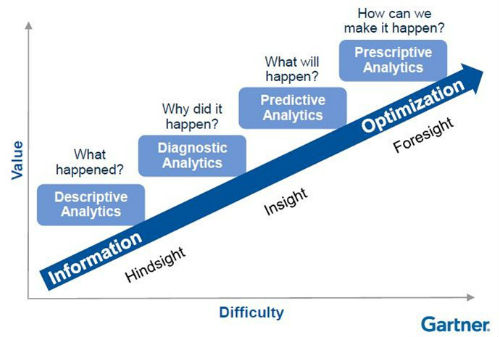
What is predictive marketing and what are the future marketing technologies we should be paying attention to?
To answer those questions and more, I am happy to share the next in our series of digital marketer interviews featuring Jeff Marcoux (@jeffmarcoux), CMO Lead, Worldwide Enterprise Marketing at Microsoft.
At Microsoft, Jeff has driven cross product and team collaboration, supported multiple product releases and believes that every touch point with a customer is a marketing experience – from marketing to sales to customer service.
In this interview, Jeff talks about the most fun job in the world at Microsoft, marketing technology and predictive analytics, marketing executive career advice and how he stays current in the digital marketing world. We also get to peek into his crystal ball for upcoming digital marketing trends.
 What does your role as CMO Lead, Enterprise Marketing involve – what are your primary responsibilities? And what’s the best thing about working for Microsoft?
What does your role as CMO Lead, Enterprise Marketing involve – what are your primary responsibilities? And what’s the best thing about working for Microsoft?
I have one of the most fun jobs in the world – to look across everything that Microsoft has from holo-lens to advertising, security to predictive marketing and figure out what Microsoft can do to empower marketers to activate around their data and to become more customer centric.
My role entails a lot of storytelling, engaging with customers, developing innovative content strategies, social, and working with our field teams to execute amazing campaigns. I get to dabble across all of the groups at Microsoft and help our own business transform in the digital age.
I think my favorite thing about working for Microsoft is the ‘New Microsoft’ that has started to shape under Satya’s leadership. It has brought about a new passion and innovation and I’m very excited to be a part of all the amazing work and innovations we are doing.
How do you balance hiring more marketing staff vs. using outside vendors and agencies? What trends to you see in terms of outsourcing vs. insourcing marketing talent?
I think it comes down to two simple things:
- Keep your core competencies core (and hired internally)
- Ensure you have the right resources to stay agile if the need arises
With things like analytics and strategy, it is critical to have the right people internally. As other areas like content marketing, marketing automation, or advanced analytics become critical, you should hire for those roles vs. outsourcing them.
I’m a fan of creating agile marketing pods that can tackle any project and quickly deliver against the team’s priorities.
Things like one offs and high production projects are great to give to agencies as well as tactics/strategies that you are piloting before determining if they are going to become core to your strategy.
I’m also a fan of creating agile marketing pods that can tackle any project and quickly deliver against the team’s priorities. These types of teams must be internal.
The last thing that I like to have is a vendor/agency on retainer for when things come up so that you can absorb fire drills, last minute requests, or project overload so that you can quickly load balance and ensure you are taking care of your internal marketing team.

For those not in the know, please define “predictive analytics”.
Predictive analytics is the 3rd step on the analytics maturity curve.
You start with analytics that give you hindsight:
- Descriptive Analytics: What happened?
- Diagnostic Analytics: Why did it happen?
Then you shift into analytics that give you insight. This is where predictive analytics comes in and helps to answer the question of: What will happen?
There is one more step on the maturity curve beyond predictive and that is prescriptive analytics which answers, “How can we make it happen?”, and provides foresight into your business. At it’s core, predictive is the ability to tell what will happen.
What kind of company or situation is an ideal candidate for predictive marketing? Is it only for large, enterprise organizations or can mid-market companies play too?
I think any company can benefit from predictive marketing. It is the level and complexity that vary based on size of company.
Pretty much any predictive scenario is based around the company wanting to use data to enhance their customer experience and provide more relevant marketing.
There are simple solutions out there that can help companies use machine learning to predict customer churn, create a predictive recommendation engine for a website, offer up the next best offer, and provide advanced lead scoring.
For bigger companies with more data you can get into things like predictive mobile content, prescriptive offerings and just in time delivery based on IOT. Predictive marketing can be for every business, it just depends how complex you want to go.
There are more marketing technology options available now than ever. What advice can you give to marketing executives on making marketing technology choices?
Look for things that are real innovations vs. shiny objects and keep data at the heart of all of your technology decisions, because data is the key to unlocking your customer.
What advice can you share with marketers who want to apply “every touchpoint is a marketing experience” into their programs?
I think the first step in this is to simply take your own customer journey from beginning to end to get a sense of everything your customers go through.
Take note of what was easy and what wasn’t. What enhanced the customer experience and what made you want to give up. This is one of the fastest ways to keep your customer at the center of your business and give you the data points you need to engage with your sales teams and customer service teams on the topic.
Customer experience is a role everyone at the company should be invested in.
Additional steps you can take are building out personas and customer journeys to clearly map out who your audience is and how they would like to do business with your company.
The last piece is to assign someone as your CX (customer experience) lead and give them the authority to stop any project when the experience is going to be bad.
Those are some simple first steps to implementing my philosophy on customer experience. The reality is, customer experience is a role of everyone at the company should be invested in.
Let’s break out your crystal ball: What are some of the hot digital marketing topic and trends you see coming up for 2016? Any shiny objects to avoid?
I think there are three big things coming in 2016 and beyond.
- The first is IOT (Internet of Things). I think this opens up the opportunity to take customer experiences to the next level through having sensors and data about the world around us to activate personalize marketing campaigns. This will give companies and marketers an unprecedented amount of data about their customers and the ability to really provide a service rather that an ad to their customers.
- The second, is mobile marketing and beacon technology. For so long we have thought that mobile marketing consisted of only pushing ads and notifications to our target audience. But now we have the ability to include indoor 3D positioning, custom curated content based on user preferences and the ability to incorporate IOT and other data sets to create amazing customer experiences.
- The last is predictive marketing and machine learning as it becomes more accessible to businesses of all sizes. This is going to enable companies to move away from simply having a dashboard to making data actionable.
All three of these digital marketing technologies can work in conjunction to help brands innovate in the marketing space and to truly provide amazing experiences for their customers.
You are on the board for the Internet Marketing Association. What advice do you have for marketing executives and volunteering time with associations? What do you get out of it and what do you get in return?
I think the Internet Marketing Association has been one of the most valuable times of my life and a huge accelerator in my career. The IMA has given me global adventures, amazing exposure, a platform for my innovation, and lifelong friends.
Volunteering time with associations enables you to be seen as a connector and a leader.
Volunteering time with associations that you find valuable enables you to be seen as a connector and a leader in the marketing space and helps to grow your network.
I am selective in what groups I give my time as many marketing associations are simply new sales people looking to sell or just out of college young professionals looking for a job. It can be hard for a marketing executive to find associations worth their time. I would encourage all marketing executives to check out the Internet Marketing Association and Content Marketing Institute.
What career advice would you give to rising digital marketing executives on skills and advancing their career?
I think one of the most important things you can do is get a mentor. Mentors are great at giving coaching and helping you navigate the road ahead given they have already been on it.
Second, I recommend pursuing a leadership role in a local or national marketing association to grow your profile and network.
Third, is publish on your own blog or LinkedIn profile to help gain credibility on the topics you wish to be known for.
The last piece I would recommend is always keep learning about new marketing technologies, strategies, and frameworks through books, podcasts, published research, TED talks, etc.
I read and learn as much as I can to enable myself to be a more effective marketing manager. These are the things that I recommend to my students at UC Irvine and to anyone I mentor as they are an investment in yourself and your future.
How do you deal with information overload in the marketing world and what marketing and technology information resources do you rely on to stay current?
There are a lot of ‘hot’ things always coming out in the marketing world and what I look for are the ones that seem like game changers.
Every day I start out reviewing TechCrunch looking for trends and things that are impacting companies I’m interested in. I also keep a pulse on VC investments in marketing startups to see where the innovation is at.
Monitoring upcoming trends like mobile marketing (not just push ads), IOT, machine learning, drones, etc. that are likely to impact customer experience are all on my watch list to understand how the technology could be applied for marketing.
So my shortlist for keeping up to date:
- TechCrunch
- eMarketer
- Adobe’s Digital Index report
- Associations I am a member of
- Following industry leaders and professors through twitter and other channels
Let’s play social media word association. I’ll list social networks and media sites and you reply with what comes to mind first:
- Facebook – The Original Social Network
- Vine – Hold my beer, watch this
- LinkedIn – My professional world
- Twitter – ADHD #hashtag
- Meerkat or Periscope – Watch me live
- Google+ – Google employees & people on Gmail/YouTube
- Snapchat – No one can copy this right…
- YouTube – The new DIY site
- Instagram – #foodstagram
- Flickr – I’m a photographer and want to be social
- Pinterest – All the stuff I would do if I had time, #pinterestfails
- MySpace – Musicians who don’t get love, #middleschool
Thanks Jeff!
You can find Jeff on Twitter and LinkedIn.
Be sure to check out our next Digital Marketing Spotlight interview with Rishi Dave, CMO at Dun & Bradstreet.
Top photo: Shutterstock


